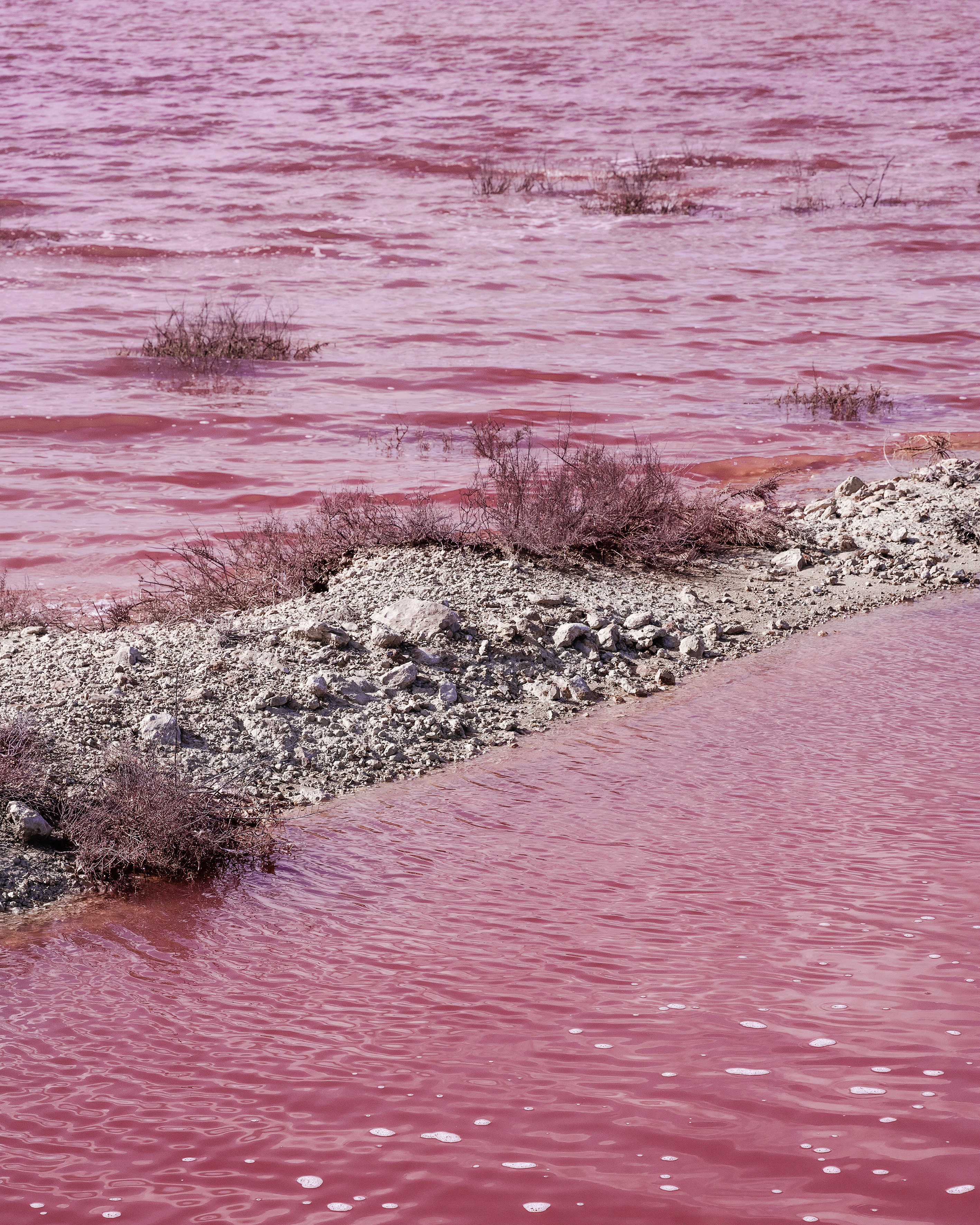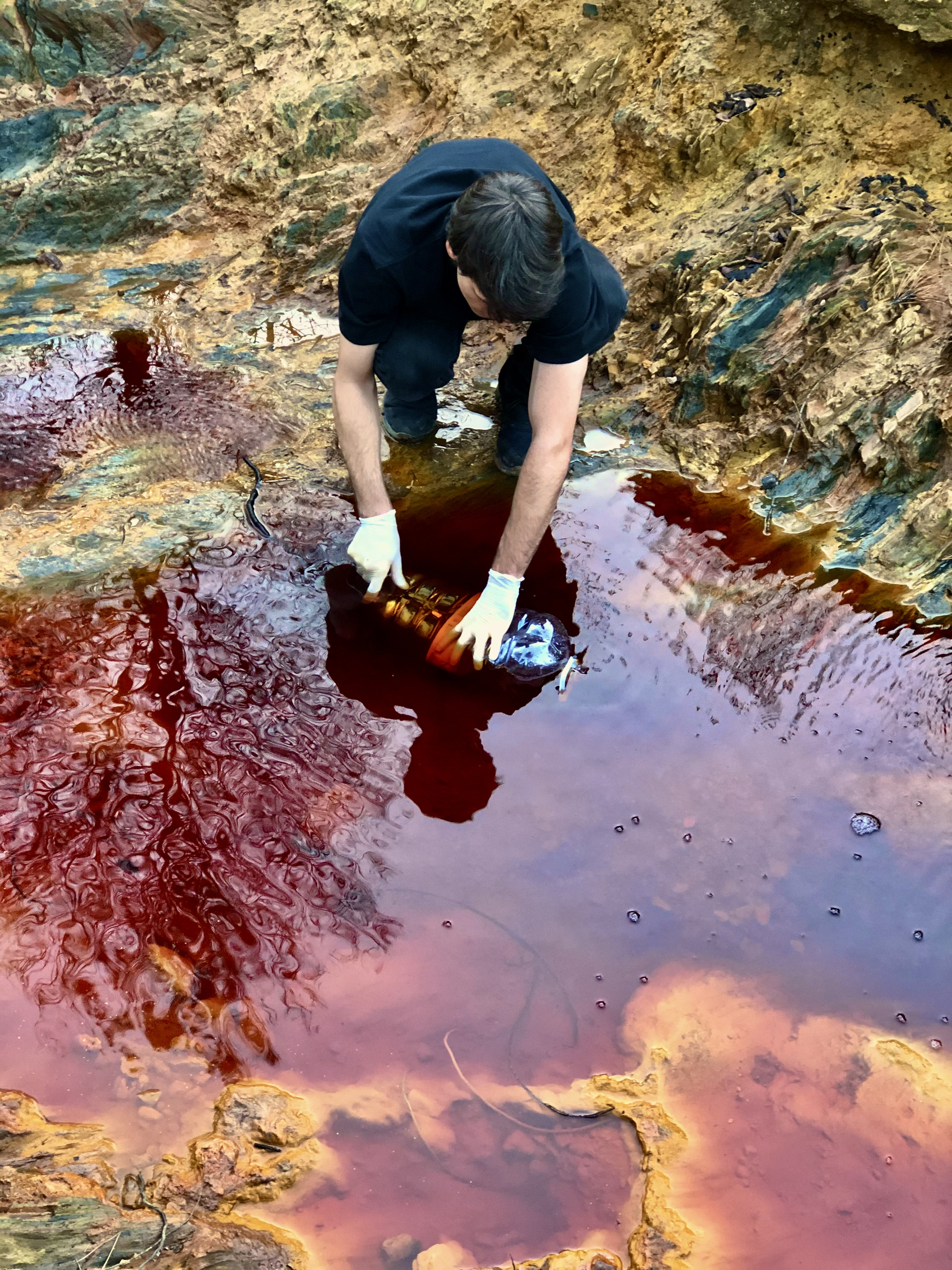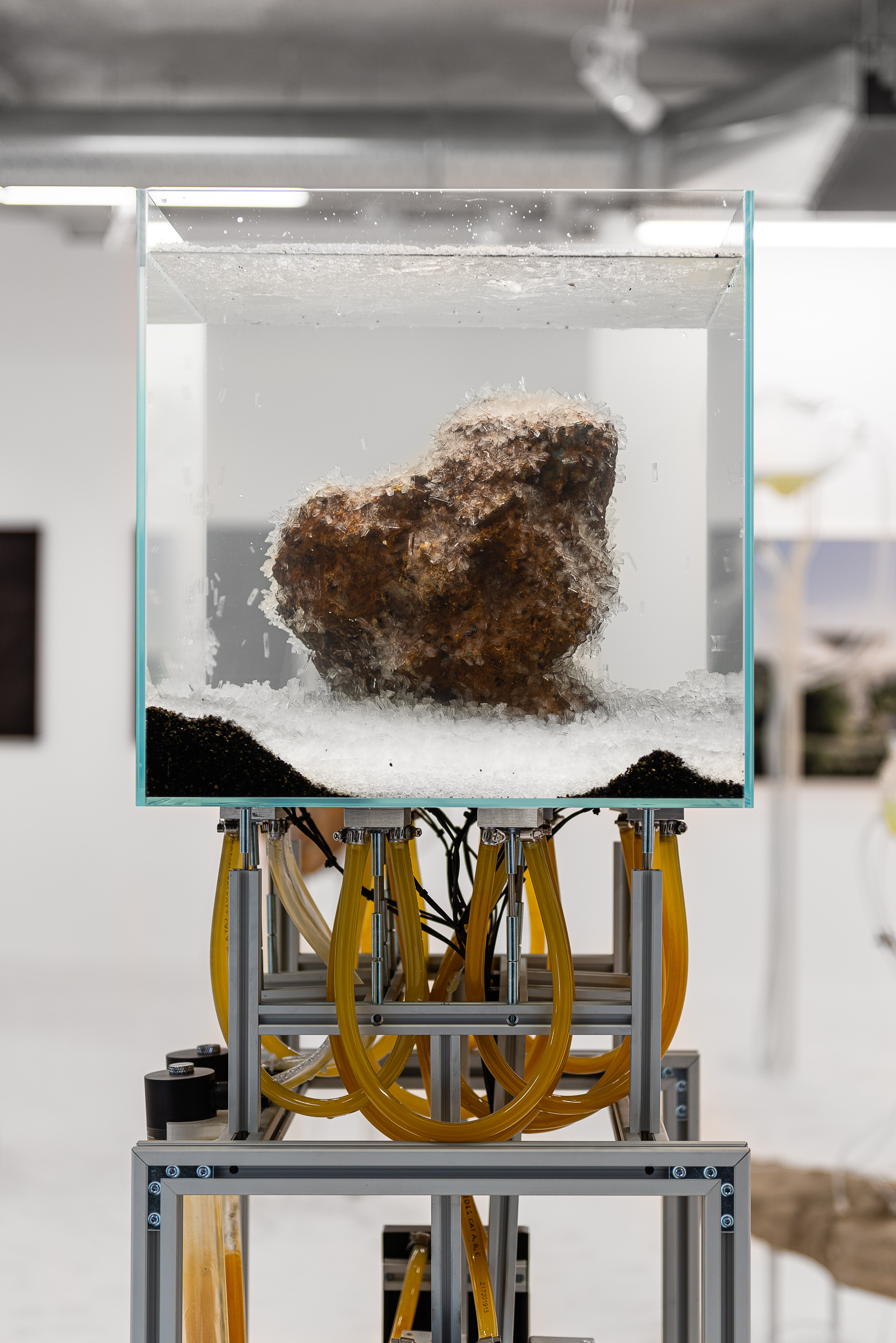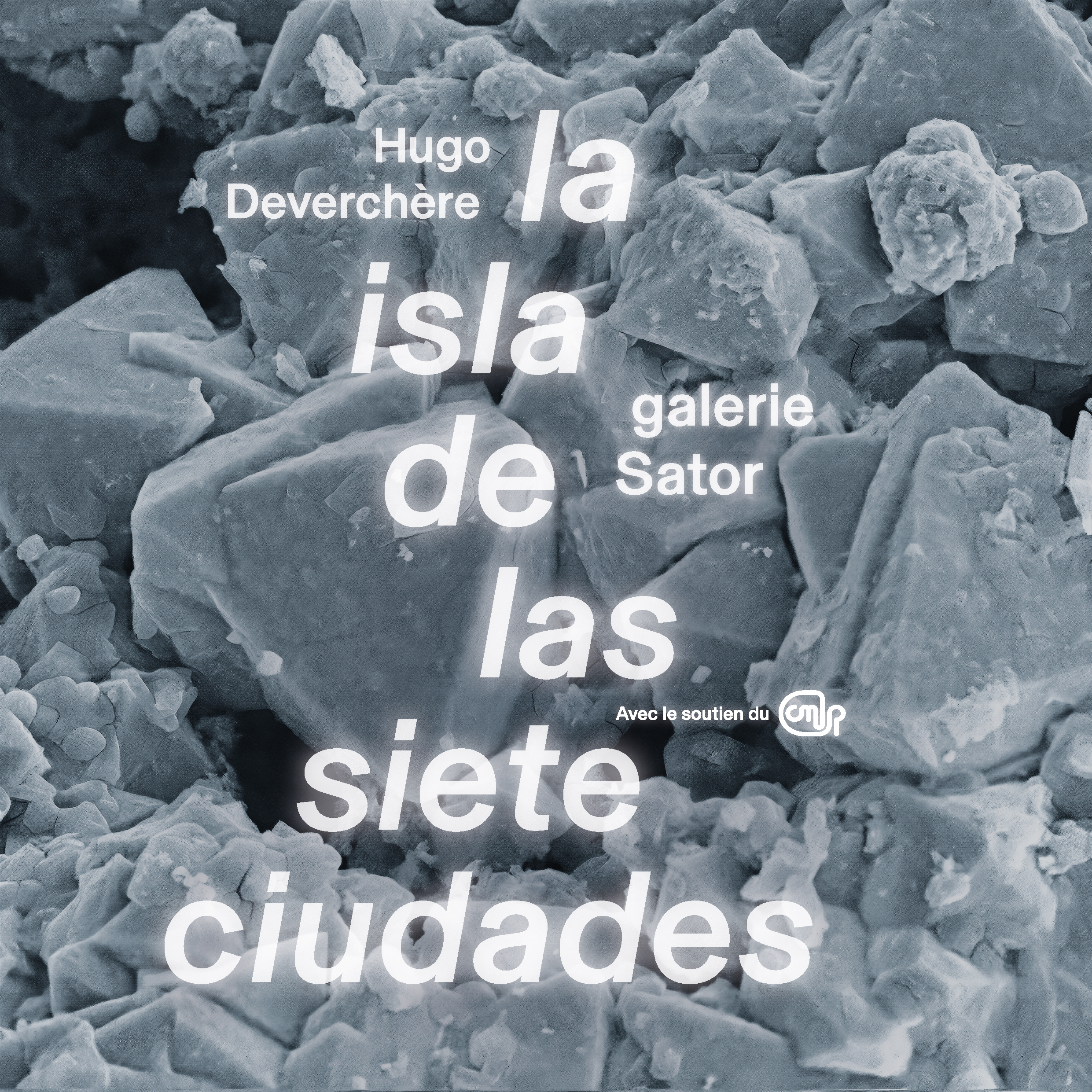The Afterimage
The Far Side
La Isla de las Siete Ciudades
Magnetites
The Crystal & the Blind [PART 1]
The Crystal & the Blind [PART 2]
Cosmorama
Cosmorama [Recordings]
Delusion
Inserts in the Uncertainty
Lunarium
[+]
SOLO SHOWS
The Afterimage
The Far Side
La Isla de las Siete Ciudades
The Crystal & The Blind
[PART 2]
Objects in the Mirror may look closer than they appear
GROUP SHOWS
Voir/le temps/en couleurs - Centre Pompidou Metz
Bercer la Matrice - CAC La Traverse
Les vies Minuscules - Collection Lambert Avignon
La Mesure du Monde - MRAC Occitanie Sérignan
Le Rêve des Formes - Palais de Tokyo Paris
[+]
LA ISLA DE LAS SIETE CIUDADES ― 2021
[FR]
14 MARS ― 16 MAI 2021
Galerie Sator Komunuma, Romainville, France
Exposition personnelle
[EN]
Galerie Sator Komunuma, Romainville, France
MARCH 14 ― MAY 16 2021
Galerie Sator Komunuma, Romainville, France
Solo show
![]() ︎︎︎ Photos ©
Grégory Copitet
︎︎︎ Photos ©
Grégory Copitet



TXT[FR]
L’exposition se construit autour d’une recherche anachronique qui remonte à la fois aux origines de cette légende et à ses ramifications dans nos mythologies contemporaines, la récente découverte d’exoplanètes ayant aujourd’hui réactivé et déplacé le fantasme de mondes inexplorés vers le cosmos. En convoquant différents champs d’investigation comme la géologie, la microbiologie, l’astronomie, l’archéologie ou encore l’alchimie, l’artiste active ici des processus qui permettent l’émergence d’un monde nouveau, évocation d’un territoire peut-être disparu ou encore inconnu.
Pendant sa résidence à la Casa de Velázquez en 2020, Hugo Deverchère a tenté de retrouver les milieux naturels qui, selon certains historiens, auraient pu inspirer les vagues descriptions qui subsistent de ce territoire fictif : le lac salé de Torrevieja, le désert des Bardenas Reales, la mine du Rio Tinto ou encore la montagn du Calar Alto. Cette exploration lui a permis de rassembler la matière visuelle et première de cette exposition : composés chimiques, organiques et minéraux du paysage. À travers cette enquête inversée, il n’était plus question de chercher à démontrer l’existence d’un territoire hypothétique mais de trouver dans le réel des manifestations de ses imaginaires, et d’en actualiser les représentations.
Nous découvrons ici un environnement sensible où les œuvres forment un faisceau d’indices qui esquissent une géographie mouvante. C’est un voyage à travers les différentes échelles du paysage, observé et disséqué par de multiples outils allant du microscope au télescope.
A travers des dispositifs qui permettent aux matériaux récoltés par l’artiste lors de ses explorations de se rencontrer et d’interagir, des processus de croissance, de cristallisation, de développement, de transformation ou de dégradation rejouent, durant le temps de l’exposition, des phénomènes géologiques et chimiques qui s’établissent d’ordinaire à des échelles de temps immémoriales.
L’exposition nous plonge dans les états possibles de la matière et sa transmutation. Elle dévoile des strates imperceptibles du paysage qui, à travers leur métamorphose, génère un nouveau territoire à la fois possible et imaginaire.
« La Isla de las Siete Ciudades » désigne un ensemble d’îles fantômes un temps situé au large de la péninsule ibérique au XV et XVIe siècle. Pendant cette période, l’archipel change de nom, de forme, et dérive progressivement dans l’océan Atlantique au fil de ses apparitions successives sur les cartes espagnoles, italiennes, allemandes et turques de l’époque. Il est une dernièr fois situé dans la mer des Caraïbes avant de disparaitre, son histoire se dilue et se mue alors en d’autres mythes, comme celui des Sept Cités d’Or. Restent des descriptions de mondes magiques et des rêves de pierres précieuses.
L’exposition se construit autour d’une recherche anachronique qui remonte à la fois aux origines de cette légende et à ses ramifications dans nos mythologies contemporaines, la récente découverte d’exoplanètes ayant aujourd’hui réactivé et déplacé le fantasme de mondes inexplorés vers le cosmos. En convoquant différents champs d’investigation comme la géologie, la microbiologie, l’astronomie, l’archéologie ou encore l’alchimie, l’artiste active ici des processus qui permettent l’émergence d’un monde nouveau, évocation d’un territoire peut-être disparu ou encore inconnu.
Pendant sa résidence à la Casa de Velázquez en 2020, Hugo Deverchère a tenté de retrouver les milieux naturels qui, selon certains historiens, auraient pu inspirer les vagues descriptions qui subsistent de ce territoire fictif : le lac salé de Torrevieja, le désert des Bardenas Reales, la mine du Rio Tinto ou encore la montagn du Calar Alto. Cette exploration lui a permis de rassembler la matière visuelle et première de cette exposition : composés chimiques, organiques et minéraux du paysage. À travers cette enquête inversée, il n’était plus question de chercher à démontrer l’existence d’un territoire hypothétique mais de trouver dans le réel des manifestations de ses imaginaires, et d’en actualiser les représentations.
Nous découvrons ici un environnement sensible où les œuvres forment un faisceau d’indices qui esquissent une géographie mouvante. C’est un voyage à travers les différentes échelles du paysage, observé et disséqué par de multiples outils allant du microscope au télescope.
A travers des dispositifs qui permettent aux matériaux récoltés par l’artiste lors de ses explorations de se rencontrer et d’interagir, des processus de croissance, de cristallisation, de développement, de transformation ou de dégradation rejouent, durant le temps de l’exposition, des phénomènes géologiques et chimiques qui s’établissent d’ordinaire à des échelles de temps immémoriales.
L’exposition nous plonge dans les états possibles de la matière et sa transmutation. Elle dévoile des strates imperceptibles du paysage qui, à travers leur métamorphose, génère un nouveau territoire à la fois possible et imaginaire.
TXT[EN]
The “Isla de las Siete Ciudades” is the name of a
group of ghost islands that was once believed to
be situated off the coast of the Iberian Peninsula
between the 15th and the 16th centuries. Over
the course of this period, the archipelago
changed name, shape, and position, with
successive Spanish, Italian, German and Turkish
maps showing it gradually drifting out into the
Atlantic Ocean. It appears one last time in the
Caribbean Sea before vanishing altogether, as
its history blends with other myths, like that of
the Seven Cities of Gold. What remains today are
descriptions of magical worlds and dreams of
precious gems.
This exhibition is based on a deliberately anachronistic research project which seeks out the origins of this legend as well as looking to its ramifications for our contemporary mythologies, at a time when the recent discovery of exoplanets has reactivated and transposed the fantasy of unexplored worlds to the cosmos. Bringing together various fields of research such as geology, microbiology, astronomy, archaeology and alchemy, Hugo Deverchère activates processes that allow for the emergence of a new world and the evocation of a territory that may have disappeared – or that has yet to be found.
During his residency at Casa de Velázquez in 2020, Deverchère set out to find the natural environments that some historians believe could have inspired the vague descriptions of this fictional territory: the salt lake of Torrevieja, the Bardenas Reales desert, the mine of Rio Tinto or the mountain of Calar Alto. This exploration enabled him to assemble the raw visual material of this exhibition, consisting of chemical, organic and mineral compounds of the landscape. In this reverse study, it was no longer a question of proving the existence of a hypothetical territory but rather of locating the manifestations of its imaginaries in the real world and to bringing them into being.
Here we discover a sensitive environment where the works form a series of clues that trace out a drifting geography, a journey through the different scales of landscape that is observed and dissected by multiple tools ranging from microscopes to telescopes.
These installations allow the materials gathered by the artist in his exploratory research to encounter and interact with one another. Processes of growth, crystallization, development, transformation and decomposition play out over the duration of the exhibition, recreating geological and chemical phenomena that usually take place over epochal time scales.
The exhibition immerses us in possible states of material and their fluxes. It unveils imperceptible strata of landscape which, through their metamorphosis, generate a new territory that is both possible and imaginary.
The “Isla de las Siete Ciudades” is the name of a
group of ghost islands that was once believed to
be situated off the coast of the Iberian Peninsula
between the 15th and the 16th centuries. Over
the course of this period, the archipelago
changed name, shape, and position, with
successive Spanish, Italian, German and Turkish
maps showing it gradually drifting out into the
Atlantic Ocean. It appears one last time in the
Caribbean Sea before vanishing altogether, as
its history blends with other myths, like that of
the Seven Cities of Gold. What remains today are
descriptions of magical worlds and dreams of
precious gems.
This exhibition is based on a deliberately anachronistic research project which seeks out the origins of this legend as well as looking to its ramifications for our contemporary mythologies, at a time when the recent discovery of exoplanets has reactivated and transposed the fantasy of unexplored worlds to the cosmos. Bringing together various fields of research such as geology, microbiology, astronomy, archaeology and alchemy, Hugo Deverchère activates processes that allow for the emergence of a new world and the evocation of a territory that may have disappeared – or that has yet to be found.
During his residency at Casa de Velázquez in 2020, Deverchère set out to find the natural environments that some historians believe could have inspired the vague descriptions of this fictional territory: the salt lake of Torrevieja, the Bardenas Reales desert, the mine of Rio Tinto or the mountain of Calar Alto. This exploration enabled him to assemble the raw visual material of this exhibition, consisting of chemical, organic and mineral compounds of the landscape. In this reverse study, it was no longer a question of proving the existence of a hypothetical territory but rather of locating the manifestations of its imaginaries in the real world and to bringing them into being.
Here we discover a sensitive environment where the works form a series of clues that trace out a drifting geography, a journey through the different scales of landscape that is observed and dissected by multiple tools ranging from microscopes to telescopes.
These installations allow the materials gathered by the artist in his exploratory research to encounter and interact with one another. Processes of growth, crystallization, development, transformation and decomposition play out over the duration of the exhibition, recreating geological and chemical phenomena that usually take place over epochal time scales.
The exhibition immerses us in possible states of material and their fluxes. It unveils imperceptible strata of landscape which, through their metamorphosis, generate a new territory that is both possible and imaginary.

︎
Artefact #02, 2021
Tirage pigmentaire sur papier hahnemühle Photo Rag Ultra Smooth / Pigment print on hahnemühle Photo Rag Ultra Smooth paper / 69 x 56 cm

︎Work in progress, Spain, 2020


TXT[FR]
« La Isla de las siete ciudades » est de ces expositions qui balayent tout sur leur passage. De celles qui font le jeu de l’absorption sans verser dans le spectaculaire, de celles qui immergent, engloutissent et recrachent les spectateur.ices, devenu.es le temps d’une visite arpenteur.ses des territoires rêvés d’un ailleurs.
Hugo Deverchère (né en 1988, vit et travaille à Paris) y revêt la double casquette d’artiste et d’alchimiste, tissant l’histoire fictionnelle d’un archipel mystérieusement apparu, disparu et réapparu des cartographies au fil des siècles. Créées lors d’une résidence en 2020 à la Casa de Velàzquez, à Madrid, la quinzaine de photographies, de sculptures et les deux vidéos qui y sont présentées imaginent les formes qu’aurait pris le vivant sur cet archipel fictif.
L’exposition repositionne des enjeux divers : celui de la relation noueuse de l’humain et la machine, celui de la place qu’occupent le mythe et l’exobiologie dans la construction de nos cosmologies contemporaines.
L’objet machinal y devient sujet, doué d’entité propre et actant son histoire. Le travail d’Hugo Deverchère soulève plus de questions qu’il n’y répond : il interroge la manière dont les technosciences redéfinissent l’être humain, celle aussi des processus mutationnels de la matière et des strates géologiques terrestres.
Il signe l’univers d’une uchronie projetée à distance, suffisamment proche pour qu’on s’y sente néanmoins « chez soi ».
︎ Sophie Bernal, The Steidz, 07 avril 2021
︎ thesteidz.com







TXT[FR]
Les matériaux chimiques et minéraux récoltés au cours des explorations de l’artiste sont assemblés et réactivés par un ensemble de sculptures dont le réseau se déploie à travers tout l’espace. L’installation rejoue et transpose dans le domaine physique le processus mental qui a conduit à l’émergence de l’archipel fantôme à l’origine du projet - territoire à la fois fantasmé et modelé à partir de fragments du réel.
Faisant écho aux recherches alchimiques importées en Espagne pendant les conquêtes, les formes en verre soufflé suggèrent une matière en ébullition et renvoient à ses changements d’état, à sa transmutation. Elles sont les organes d’une entité à la fois minérale, vivante et imaginante destinée à évoluer, se développer et contaminer l’ensemble de l’espace.
À travers cette entité, les éléments hétérogènes prélevés en différents milieux naturels se réunissent et se recomposent. Les substances s’agglomèrent, se mélangent, réagissent, cristallisent, érodent, colorent et modèlent. À travers cette métamorphose, elles génèrent un nouveau territoire chimique, organique et géologique, et nous met en présence de cet ailleurs imaginaire qui acquiert ici une consistance tangible.
TXT[EN]
The chemical and mineral materials collected during the
artist’s explorations are assembled and reactivated by a
set of sculptures whose network is deployed throughout
the space of the gallery. The installation reenacts and
transposes into the physical realm the mental process
that led to the emergence of the phantom archipelago at
the origin of the project - a territory both fantasized and
modeled from fragments of reality.
Echoing the alchemical research carried out in Spain during the conquests, the blown glass forms evoke the boiling of matter and suggests its changes of state, its transmutation. They are the organs of a mineral, living and imagining entity meant to evolve, develop and contaminate the entire space.
Through this entity, the heterogeneous elements collected in various places come together and recompose. Substances agglomerate, mix, react, crystallize, erode, color and shape. Through this metamorphosis, they generate a chemical, organic and geological new territory, and makes us witness the appearance of this imaginary elsewhere which here becomes tangible.








